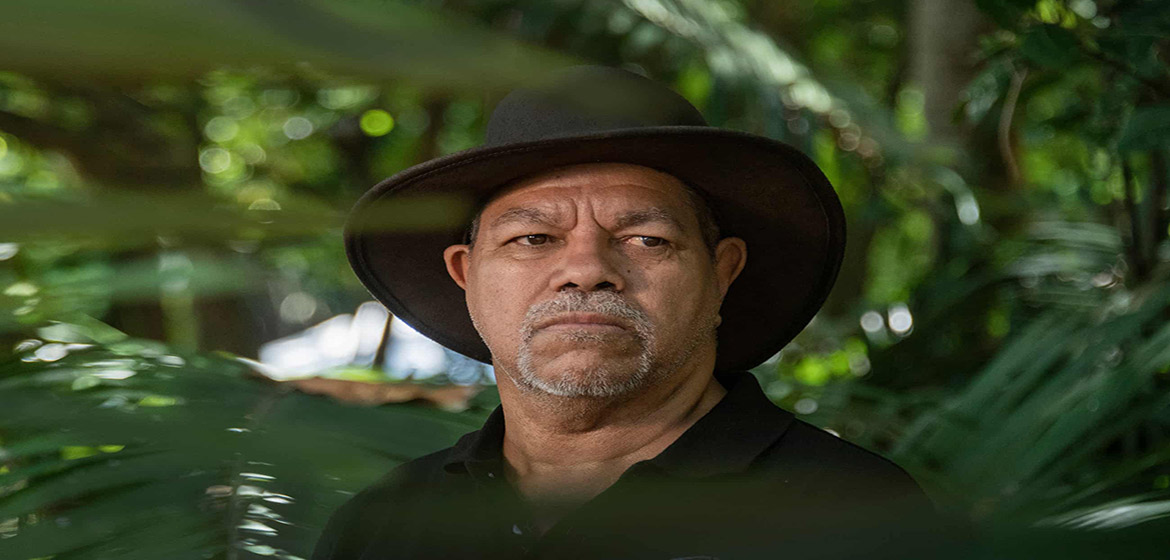Cairns event sees 120 traditional owners and scientists share insights on tackling heatwaves, rising seas and species deaths
by
More than 100 traditional owners and leading scientists from across Australia met this week to build a national First Nations voice on climate change.
From marine heatwaves and rising seas to bushfires and mass species deaths, climate change is having a major impact on First Peoples, their country, health and culture.
Internationally, Indigenous people make up less than 5% of the world’s population, but they manage and protect 80% of global biodiversity.

The mangrove forests on Admiralty Island at Trinity Inlet in Queensland. Gudjugudju Fourmile estimates that the mangroves will be submerged by 2040. Photograph: Brian Cassey/The Guardian
This week in Cairns, the CSIRO convened the National First Peoples Gathering on Climate Change. One hundred and twenty traditional owners from more than 40 nations met with climate scientists and Bureau of Meteorology experts to share insights about where, why and how fast the climate in Australia is changing.
The gathering’s co-chair, Bianca McNeair, who is a Malgana woman from Gatharagudu (Shark Bay) in Western Australia, said: “We want to be included in the climate policy, not just like ticking the box for an environmental program.”
McNeair said Aboriginal people are on the frontline daily, coping with the impacts of a changing environment.
“Changing climate affects our cultural practices, it’s changing our seasonal calendars,” she said. “All of those things are facing all our mob across Australia.
“[People here] are talking about how the birds’ movements across country have changed, so that’s changing songlines that they’ve been singing for thousands and thousands of years, and how that’s impacting them as a community and culture.
“You know, we are very resilient people, so it’s a challenge we were ready to take on. But now we’re facing a situation that’s not predictable, it’s not part of our natural environmental pattern.”
McNeair said Aboriginal knowledge holders and the scientific community at the conference have agreed on guidelines for ethical and culturally appropriate partnerships, which are essential to mitigation and adaptation.
On her homelands at Gatharagudu at Shark Bay, working with scientists, they’ve begun planting sea grasses for carbon sequestration.
“We’re learning from the scientists how to plant the seagrass, which was not something that was part of our traditional culture because we never really had to do that – it was managed through other means. We didn’t have this whole global warming, which is raising the temperature of our water,” McNeair said.

Climate change specialist and senior principal research scientist Dr Kathleen McInnes of CSIRO Melbourne prepares to view the coral at Green Island during the tour. Photograph: Brian Cassey/The Guardian
“We were saying to the scientists, ‘What’s wrong with our dugong and turtles?’ And they were explaining about the marine heatwave, and how that’s all changing.
“So one of the things that I’ve learned is what the [seagrass] seedlings look like, and how to plant them.
“For me, as a saltwater person, that means I’m planting a tree in the ocean, and I’m planting a tree that’s going to take in 10 times more carbon than a tree on land. That, to me, is really exciting and it’s keeping our spiritual connection to country that keeps giving us hope.”
The gathering is currently drafting a national statement on climate change, due to be released soon.
“Aboriginal people manage 80% of the world’s biodiversity,” McNeair says. “We’re in this position where we can make a big change, but we need to be listened to.
“What we really need is to be able to get to the top levels of government and be heard and be included in that discussion and developing those climate change policies.”
Source:
Related to SDG 13: Climate action



